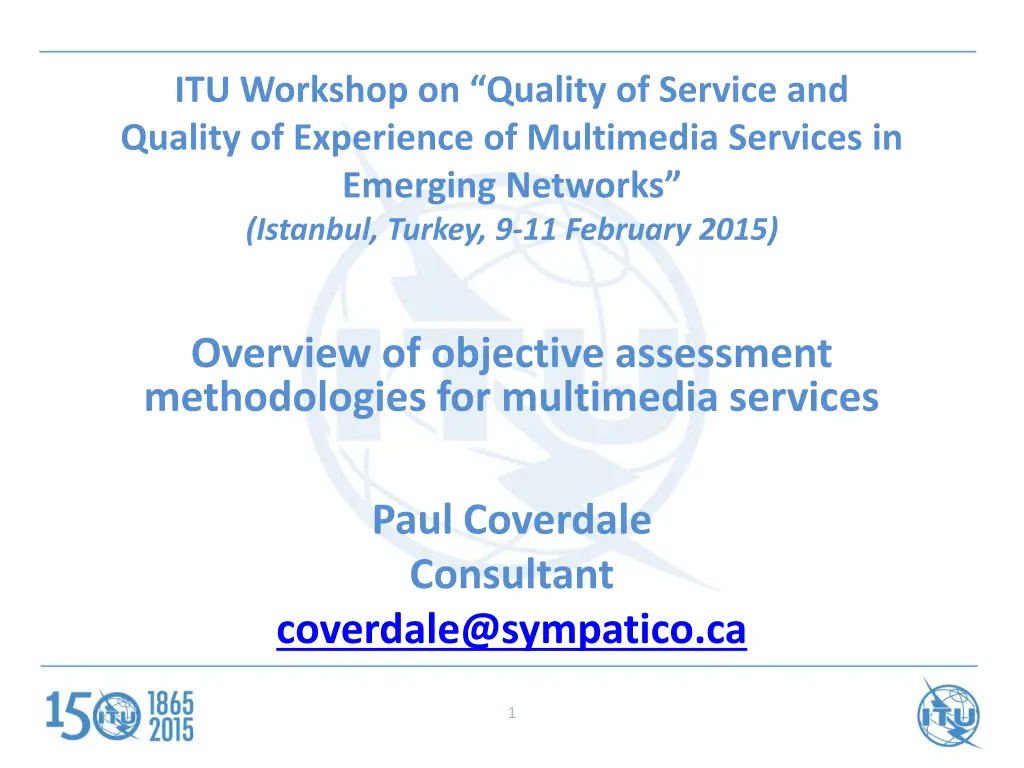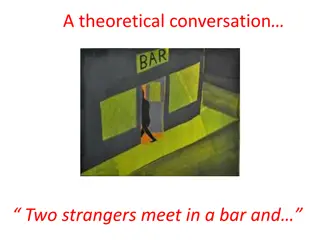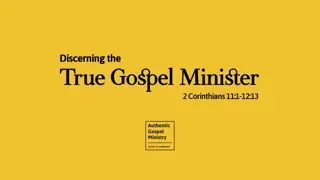
Objective Assessment Methodologies for Multimedia Quality
Learn about the goal, application, types, and Perceptual Objective Quality Measurements in the context of objective assessment methodologies for multimedia services. Explore how QoE can be estimated objectively to enhance quality planning and testing processes.
Download Presentation

Please find below an Image/Link to download the presentation.
The content on the website is provided AS IS for your information and personal use only. It may not be sold, licensed, or shared on other websites without obtaining consent from the author. If you encounter any issues during the download, it is possible that the publisher has removed the file from their server.
You are allowed to download the files provided on this website for personal or commercial use, subject to the condition that they are used lawfully. All files are the property of their respective owners.
The content on the website is provided AS IS for your information and personal use only. It may not be sold, licensed, or shared on other websites without obtaining consent from the author.
E N D
Presentation Transcript
ITU Workshop on Quality of Service and Quality of Experience of Multimedia Services in Emerging Networks (Istanbul, Turkey, 9-11 February 2015) Overview of objective assessment methodologies for multimedia services Paul Coverdale Consultant coverdale@sympatico.ca 1
Goal of objective assessment methodologies By definition, QoE is measured subjectively But this is expensive and time-consuming, and may not be practical in many cases Alternative is to make objective measurements, and use a model to estimate QoE Relies on validating the objective estimation model against unknown subjective databases 2
Application of objective assessment methodologies Planning refers to estimating the perceived quality of experience of networks/systems before they are implemented. Since it is not used in a real-time environment, no real-time inputs are required to the objective model. Accuracy of quality estimation generally more of a concern than computational complexity. Lab-testing refers to estimating the perceived quality of experience of networks/systems in the laboratory while the equipment is being developed. Requires real-time inputs. Accuracy of quality estimation generally more of a concern than computational complexity. Monitoring refers to estimating the perceived quality of experience of networks/systems that are operational. Requires real-time inputs. Trade-off between accuracy of quality estimation and computational complexity. 3
Types of multimedia assessment models There are five different types of objective multimedia quality assessment models: Perceptual models The input to the model is the media itself (audio and video signals). Parametric models. The input to the model is information derived from the packet stream and client state information. A parametric model also needs additional side-information such as codec type and bit-rate. Bit-stream models. The input to the model is information derived from the bit-stream and other packet information. Possible input is also client state information. Hybrid models. The input to the model is the media and the bit-stream. Possibly also general packet information and client state information. Planning models The input to the model includes the quality planning parameters of networks or terminals. It usually requires prior knowledge about the system under test. 4
Perceptual Objective Quality Measurements For perceptual models, gaining access to the media itself has important considerations 3 basic approaches: Full-Reference (FR) Also known as intrusive, active, double-ended No Reference (RR) Also known as non-intrusive, passive, single-ended Reduced Reference (RR) 5
Full-Reference (FR) The QoE estimation algorithm requires access to both the reference input and the degraded output Reference input System under test Degraded output QoE estimation algorithm MOS 6
Strengths/weaknesses of FR FR models generally give the most accurate quality estimation, but are more difficult to implement due to the need to have simultaneous access to both the reference input and degraded output. 7
No-Reference (NR) The QoE estimation algorithm only requires access to the degraded output. Reference input System under test Degraded output QoE estimation algorithm MOS 8
Strengths/weaknesses of NR NR models generally give a lower accuracy quality estimation, but are more convenient to implement due to the need for access to only the degraded output. 9
Reduced-Reference (RR) The QoE estimation algorithm requires access to the degraded output and some limited features extracted from the reference input. Reference input System under test Degraded output QoE estimation algorithm Feature extraction algorithm MOS 10
Strengths/weaknesses of RR RR models generally give a lower accuracy quality estimation, but are more convenient to implement due to the need for access to only the degraded output. 11
Summary of current ITU-T models Conversational (CONV)/Non- conversational (NONCONV) Objective test methodology Subjective test methodology Application Media Primary usage Model FR/RR/NR [ITU-T P.862] + [ITU-T P.862.1] (NB) [ITU-T P.862.2] (WB) [ITU-T P.863] (NB/WB/SWB) [ITU-T P.800] [ITU-T P.830] [ITU-T P.835] [ITU-T P.1301] FR LAB, MON NONCONV Telephony Speech [ITU-T P.563] (NB) [ITU-T P.564] (NB/WB) NR MON [ITU-T G.107] (NB) NR PLN [ITU-T P.800] [ITU-T P.805] [ITU-T P.1301] CONV [ITU-T P.561] + [ITU-T P.562] (NB/WB) [ITU-T G.1070] (NB/WB) NR MON [ITU-T P.920] [ITU-T P.1301] Multimedia (Note) Video telephony CONV NR PLN 12
Summary of current ITU-T models Conversational (CONV)/Non- conversational (NONCONV) Objective test methodology Subjective test methodology Application Media Primary usage Model FR/RR/NR [ITU-T J.144] (SD) [ITU-T J.247] (QCIF, CIF, VGA) [ITU-T J.341] (HD) [ITU-T J.249] (SD) [ITU-T J.246] (QCIF, CIF, VGA) [ITU-T J.342] (HD) FR LAB, MON [ITU-T P.910] [ITU-T J.140] [ITU-R BT.500-13] Video NONCONV RR MON [ITU-T P.830] [ITU-R BS.1116-1] [ITU-R BS.1285] [ITU-R BS.1534-1] Video streaming (Mobile TV/IPTV) Audio NONCONV [ITU-R BS.1387] FR/RR MON/PLN [ITU-T P.1201.1] (QCIF, QVGA, HVGA) [ITU-T P.1201.2] (SD, HD) [ITU-T P.1202.1] (QCIF, QVGA, HVGA) [ITU-T P.1202.2] (SD, HD) [ITU-T G.1030] Multimedia NONCONV [ITU-T P.911] NR MON Web browsing Data NR PLN 13
For more information... ITU-T Rec. G.1011 Reference guide to quality of experience assessment methodologies ITU-T Rec. P.1401 Methods, metrics and procedures for statistical evaluation, qualification and comparison of objective quality prediction 14
THANK YOU FOR YOUR ATTENTION! 15
Input types for the different models Perceptual model Hybrid model Side information Codec Total bitrate, etc Bitstream model Parametric model Media Bitstream/payload Packet information and client state (or estimation of it) 17






















